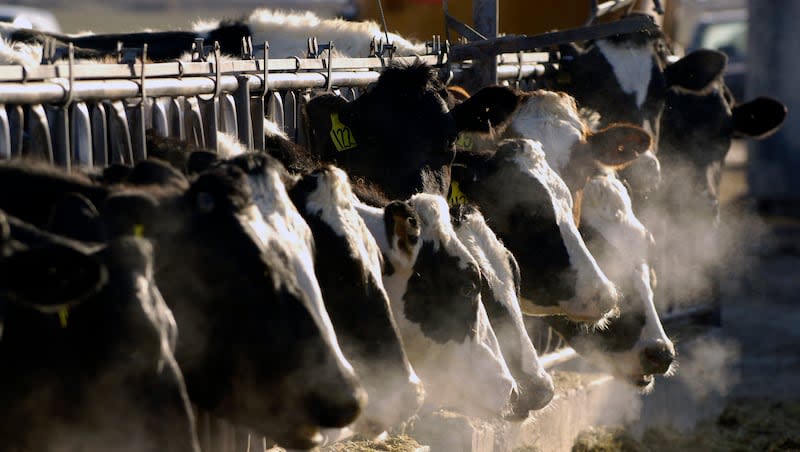CDC calls risk low, but is preparing against easier bird flu spread to people

The Centers for Disease Control and Prevention announced Friday that despite current low risk to humans from avian flu, the agency plans to boost surveillance and prepare for the possibility that could change.
In a release emailed to media Friday, the CDC said that A(H5N1) viruses “don’t have the ability to easily spread to and between people.” But the agency notes that if the virus mutates in a way that allows it to more easily infect people or spread between them, that risk assessment would rise — and so would risk of a pandemic.
The CDC says comprehensive global monitoring and investigation of every case in humans “is essential to prepare for any developments that increase the risk to human health.”
To do that, the agency said it will enhance influenza surveillance through spring and summer. “Those efforts include increasing the number of influenza A-positive test specimens available for further testing; continuing surveillance for laboratory-confirmed influenza-associated hospitalizations and encouraging clinicians to consider influenza A(H5N1) when evaluating patients who present with conjunctivitis or respiratory illness following a relevant exposure, such as attending an agricultural fair.”
Although bird flu has been found in wild birds and chickens for some time — and a number of mammals from bears to mountain lions have been sickened and in some cases died nationwide — the concern now is focused on dairy cattle herds, due to the recent multi-state outbreak.
In both cases where a human got confirmed bird flu in the U.S. this year, those who were infected worked with dairy cattle and the infection showed up as pink eye with mild symptoms. Others have not been that fortunate. The World Health Organization has said that just over half of people infected with bird flu died, while many more got sick.
The CDC said as part of its beefed-up surveillance it is also evaluating the lab tests now available, as well as vaccines and antiviral treatments. The agency said it’s supporting states as they monitor for infections.
Food surveillance
According to the CDC, those exposed to infected animals or materials that might be contaminated, including by drinking raw cow milk are at greater risk and should take precautions. Those steps include wearing personal protective equipment, self-monitoring for signs of illness and seeking both medical testing for influenza and care quickly if the virus is detected.
They’ve also been watching the food supply. The virus was found in raw milk from the infected dairy herds, though health officials say pasteurization kills it. The U.S. Department of Agriculture says cooking hamburger to recommended temperatures makes meat safe, too.
Doing enough?
Sen. Mitt Romney is among those who’ve suggested that the federal government needs to do more to protect people from the risks posed by avian influenza. As Deseret News earlier reported, “I am alarmed by reports about the rapid spread of the bird flu virus (H5N1), and concerned that your agencies are not moving quickly enough to understand and contain the outbreak,” the Utah Republican said in a letter to the heads of the U.S. Food and Drug Administration, USDA and CDC in early May.
“It is critical that you work swiftly to get ahead of this emerging situation and reassure the American public that they — and our food supply — remain safe,” Romney wrote. “Given your agencies’ recent experience with the COVID-19 pandemic and baby formula shortage, I am concerned that once again our federal government and its interagency process appears to be caught flat-footed.”
Wrote Romney, who is not seeking reelection, “It is essential that you move to fill the existing gaps in our public health knowledge by conducting sound science and quickly disseminating accurate information.” He asked for a response to questions about the outbreak, including whether there are federal programs, like the CDC’s National Wastewater Surveillance System used to monitor COVID-19, that can also monitor for bird flu.
Surveillance challenges
In a report issued Friday, the CDC said part of the plan to contain any spread among humans, should it occur, hinges on monitoring workers who are exposed to infected herds or flocks or otherwise come in contact with infected animals or what they leave behind. The federal agencies working on this are using what they call a One Health approach, including monitoring animal exposure. One of the challenges is figuring out exposure periods. The report said that with poultry, it’s pretty simple. Many of the chickens die, but it also “creates a finite 10-day monitoring period after exposure” to see if the workers get sick.
With cattle, the illness can last two to four weeks, but how long infectious virus shedding occurs is not known. Further complicating things, some cows have had the illness when tested but have no symptoms, so workers might not know they were exposed. And the report notes the recent testing that found viral fragments in about 1 in 5 retail milk samples nationwide “suggests that A(H5N1) virus infections of cattle might be widespread. Therefore monitoring of exposed or potentially exposed persons and animals might be protracted and resource-intensive.”
The report concluded, “A coordinated and comprehensive One Health response to this ongoing outbreak of A(H5N1) virus infections in dairy cows, poultry, and other animals is needed to identify and prepare for any developments that indicate an increase in the risk to public health.”

